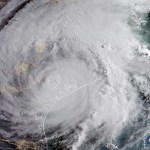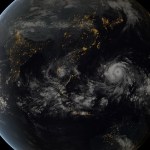Hurricane Harvey visited a near-biblical deluge upon Houston, dropping over 40 inches of rain on parts of the city. The situation resulted from warmer ocean waters, more moisture in the atmosphere, and Houston's geography along with its preparedness for the disaster. Greg Laden shows hotter sea surface temperatures in the Tropics and the Gulf of Mexico allowed Harvey to gain extra strength as it formed and re-formed on its way to the United States. In another post, Greg asks if Houston's infrastructure could have been better-prepared for this type of rainfall, suggesting that "Houston is…
Cyclones
Typhoon Haiyan, which made landfall in the Philippines on Nov. 7, is another sobering reminder of the severe weather we are provoking through climate change. It is unofficially the strongest recorded cyclone to ever make landfall, with wind speeds up to 195 mph, 70% stronger than Hurricane Sandy. Villages are flattened, and more than 5,000 people are confirmed dead (as of 11/22). Greg Laden says that tropical cyclones feed on heat energy from the sea’s surface, from seas we know are getting warmer. Haiyan was a storm that blew past the most dire classification, Category 5, which tops out at a…

